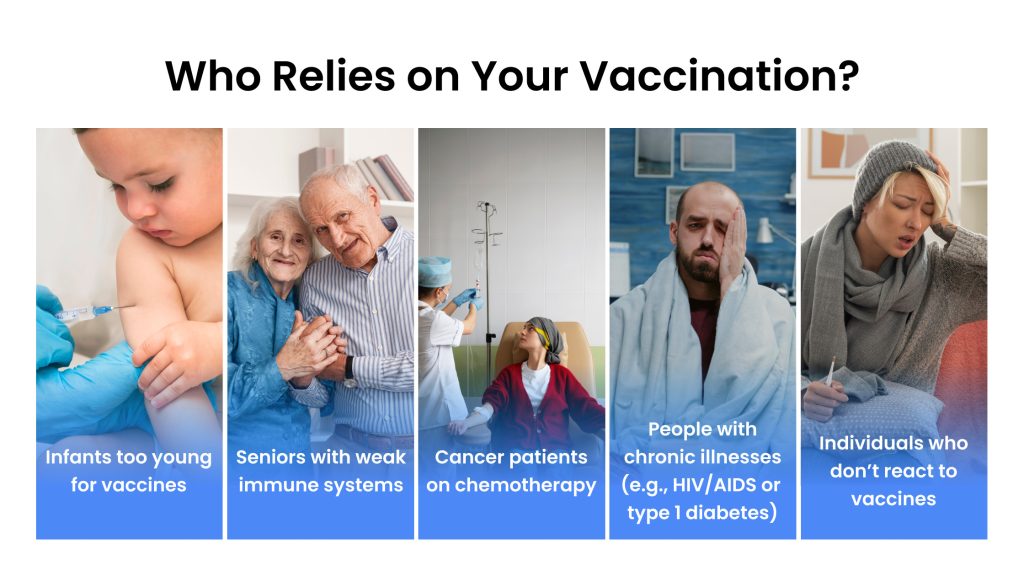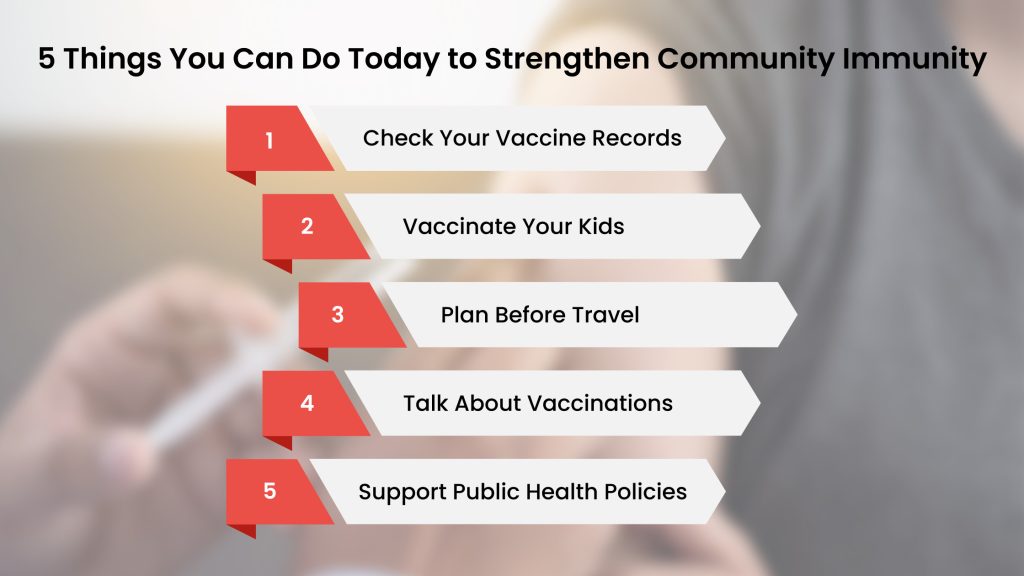You wake up one morning with a scratchy throat. It’s subtle, barely noticeable. You go about your day like nothing’s wrong, until your first bite of lunch, maybe a sandwich, where the tangy pickles send a sharp sting down your throat. If you’re not a fan of pickles, perhaps it was your iced coffee that triggered it.
Whatever the case, the discomfort is real, and by evening, you’re mentally preparing for the possibility of calling in sick tomorrow.
That slight sore throat? It’s your immune system’s alarm—a minor breach in the body’s defenses.
But more often than not, your immune system rallies, fights back, and restores balance before things spiral into a full-blown illness. This quiet, daily heroism by your body is why immunity matters. It’s your first line of defense, built over time by exposure, rest, nutrition, and crucially, by vaccination.
In 2025, as international travel resumes and communities grow ever more interconnected, our collective immunity is being put to the test. Once-contained diseases like measles are coming back to the US and Europe, not because vaccines no longer work, but because too many people are skipping them.
This resurgence is a wake-up call. It reminds us of a fundamental, often overlooked truth: your vaccination doesn’t just protect you—it protects everyone around you. And this is the concept of community immunity, or herd immunity, a public health foundation that allows even the most vulnerable among us to live safely.
In this blog, we’ll explore how community immunity works, who depends on it most, and why your vaccine truly matters more than ever.
What is Community Immunity?
Community immunity, also known as “herd immunity,” happens when a high enough percentage of people in a population are immune to a contagious disease through vaccination or previous infection, making it difficult for the disease to spread. This creates an invisible shield that protects even those who can’t get vaccinated, such as newborns, cancer patients, or individuals with immune disorders.
If you haven’t gotten vaccinated yet, or it’s simply been a while since your last check-in—schedule your first Annual Physical Health Examination with Specialty Primary Care & Wellness. It’s the perfect opportunity to assess your overall health, review your vaccination records, and ensure your immune system is ready to protect you and your community.
About 95% of the population must be immunized against highly contagious diseases like measles to maintain community immunity. This is why when you get vaccinated, you contribute to your whole community to be protected against potentially life-altering illnesses.
Who Relies on Your Vaccination?

While vaccines are critical for individual protection, they are even more vital for:
- Infants too young for vaccines
- Seniors with weak immune systems
- Cancer patients on chemotherapy
- People with chronic illnesses (e.g., HIV/AIDS or type 1 diabetes)
- Individuals who don’t react to vaccines
These groups rely on the rest of us to help block transmission. By getting vaccinated, you create a safer world for them. The following section discusses the real-world scenarios where vaccines have protected communities.
Proof of Community Immunity Practices: 7 Real World Scenarios
Pneumococcal Conjugate Vaccine (PCV): Protecting Young and Old
When the pneumococcal conjugate vaccine was added to U.S. childhood immunization schedules in 2000, it shielded kids from pneumococcal disease and dramatically reduced illness in unvaccinated older adults. This herd immunity effect led to a nine-fold decrease in invasive pneumococcal disease among seniors (65+ years) after the vaccine’s introduction.
Vaccinated children no longer carry and spread the bacteria as much, indirectly protecting their grandparents’ generation from pneumonia and bloodstream infections.
Hib Vaccine: Vanquishing a Pediatric Menace
Haemophilus influenzae type b (Hib) was once a leading cause of bacterial meningitis and pneumonia in young children. After the Hib conjugate vaccine became routine, cases plummeted so sharply that the disease has been nearly eliminated wherever the vaccine is widely used.
In the United States, for example, invasive Hib disease in children under 5 years old dropped by more than 99% within about a decade. By preventing kids from becoming carriers of Hib, vaccination created a community shield—even unvaccinated infants benefited greatly from reduced exposure to this germ.
Smallpox Vaccine: Global Eradication through Community Immunity
Smallpox is the ultimate example of community immunity on a global scale. In 1980, through coordinated mass vaccination campaigns, smallpox was declared eradicated worldwide, the only human infectious disease ever eliminated. With transmission halted by high immunity levels everywhere, even unvaccinated individuals were safe.
This historic victory underscores how herd immunity, when virtually an entire population is immunized, can drive a pathogen into extinction.
Polio Vaccine: 99% Worldwide Reduction
Polio vaccination offers another striking success story of herd immunity. Thanks to decades of immunization, wild polio cases have declined by over 99% globally since 1988, from an estimated 350,000 cases per year to only a few dozen in the last remaining endemic areas. Herd immunity has halted polio transmission in most of the world; for instance, the United States has been polio-free since 1979 due to widespread vaccination. This near-eradication illustrates how high community vaccine coverage protects everyone, including those not immunized, by stopping the virus’s spread.
HPV Vaccine: Herd Protection in Populations
In communities with high uptake of the human papillomavirus (HPV) vaccine, the spread of HPV and related diseases has dropped dramatically. Australia’s national HPV vaccination program, for example, led to a >90% decline in genital warts among young women. Notably, young men experienced a similar ~90% drop before men were even included in the vaccine program, thanks to herd immunity.
In other words, vaccinating a large proportion of adolescents against HPV not only protects them from infection, but also indirectly shields others by reducing overall virus circulation. These community-wide gains are expected to translate into sharp declines in cervical and other HPV-related cancers as well.
Meningitis A Vaccine (MenAfriVac): Ending Epidemics in Africa
The introduction of MenAfriVac (a conjugate vaccine against Group A meningococcus) across Africa’s “meningitis belt” has virtually eliminated deadly meningitis A epidemics through herd immunity. In 2010, mass vaccination campaigns reached over 360 million people in 24 countries.
The result was a >99% drop in Group A meningitis incidence in those regions; this once-devastating strain has not caused any reported outbreak since 2017. By removing the main carrier population for the bacteria, the vaccine conferred community-wide protection—even unvaccinated individuals are no longer at risk from meningitis A because the pathogen struggles to find hosts.
COVID-19 Vaccines: Community-Level Impact
While many of the examples above happened over the past few decades, the COVID-19 pandemic brought the importance of community immunity into sharp focus in real time. Vaccines showed protective effects beyond individual immunity even amid a rapidly evolving virus.
In the U.S., states with higher COVID-19 vaccination rates reported significantly fewer infections and hospitalizations, not just among the vaccinated, but also among unvaccinated individuals, proving the presence of herd protection.
At the population level, higher vaccine coverage consistently correlated with reduced mortality, hospital admissions, and outbreak severity. The more people got vaccinated, the harder it became for the virus to spread, underscoring once again that vaccination is not just personal protection, it’s community care.
Why Vaccination Matters More Than Ever in 2025
These success stories remind us what’s possible, but 2025 brings new hurdles.
- Pandemic fallout: During the COVID-19 crisis, millions of children missed routine vaccinations, creating dangerous immunity gaps around the world.
- Local under vaccination: In parts of the U.S., like Gaines County, Texas, measles vaccination rates have dipped well below the 95% threshold needed for effective community immunity.
- Global travel risks: In our interconnected world, diseases eliminated in one region can re-enter through international travel. The U.S. saw a measles outbreak in 2005 triggered by unvaccinated travelers returning from a vacation.
Your vaccination choice is critical—an act of care, responsibility, and strength. And if you come from a place with anti-vaccination beliefs, consider this: vaccination also offers financial advantages. Want to know more? Keep reading.
Economic Benefits of Community Immunity
Vaccines aren’t just a public health success; they’re one of our most cost-effective economic tools. When enough people are immunized, disease outbreaks become rare, and the entire system, from families to businesses to national economies, benefits. Healthy communities mean fewer school absences, more consistent workforce participation, and significantly lower healthcare spending.
According to the Centers for Disease Control and Prevention (CDC), for every $1 invested in the U.S. childhood immunization program, the country saves up to $44 in direct and indirect costs. This includes avoided medical treatments, reduced hospital admissions, fewer lost workdays for parents, and less burden on emergency care systems.
You may also consider these ripple effects:
- A single flu outbreak in a school can lead to widespread absenteeism, affecting children and their working parents.
- Measles outbreaks cost local and state governments millions of dollars in emergency response, contact tracing, and quarantine enforcement, even if the number of infected individuals remains relatively small.
- In low-income countries, the return on investment for vaccines is even higher. The World Health Organization estimates that vaccines will prevent 24 million people from falling into poverty by 2030, simply by reducing out-of-pocket medical expenses.
Beyond the numbers, herd immunity helps stabilize economies by keeping healthcare systems from being overwhelmed during epidemics, allowing hospitals and clinics to continue serving other critical needs.
Change begins from within, and to work towards community immunity, you may need to take the first step yourself. It’s not complicated. Just trust us and follow the steps below.
5 Things You Can Do Today to Strengthen Community Immunity

Step 1. Check Your Vaccine Records: Are You Up to Date? Know Your Status, Protect Yourself and Others.
Actionable Steps
- Find your records (doctor, school, online portal).
- Compared to the recommended schedules.
- Identify and schedule missing vaccines.
- Keep records safe.
Step 2. Vaccinate Your Kids: Staying on Schedule is an Investment in Their Future and the Community’s Health.
Actionable Steps
- Know the childhood vaccine schedule.
- Book and attend appointments.
- Keep vaccination records.
- Trust credible vaccine information.
Step 3. Plan Before Travel: Don’t Skip Travel-Specific Vaccines to Protect Yourself and Prevent the Spread of Disease Across Borders.
Actionable Steps
- Consult your doctor/travel clinic early.
- Research the destination’s vaccine needs.
- Get recommended vaccinations.
- Carry your vaccine proof.
Step 4. Talk About Vaccinations: Share Credible Vaccine Information with Your Network to Combat Misinformation and Encourage Vaccination.
Actionable Steps
- Use reliable sources (WHO, CDC, etc.).
- Share accurate info online.
- Talk respectfully, share facts.
- Share positive vaccine experiences.
Step 5. Support Public Health Policies: Push for School and Workplace Vaccination Standards.
- Actionable Steps:
- Stay informed on local vaccine policies.
- Contact your elected officials (supportive policies).
- Support pro-vaccine organizations.
- Encourage vaccination in your circles.
Bonus Step: Schedule your Annual Physical Health Examination with us!
Build Community Immunity with Specialty Primary Care & Wellness

At Specialty Primary Care & Wellness, we believe that strong communities start with healthy individuals, and prevention is the key. From chronic illnesses to vaccine-preventable diseases like influenza or cervical cancer, early detection and routine check-ups can make all the difference.
Our comprehensive, family-centered care model includes personalized health assessments designed to catch potential issues early and empower you to take proactive steps—not just for your own well-being, but for those around you.
Why Trust Us for Your Preventive & Immunization Needs?
- Convenience & Efficiency: Swift appointments with minimal wait times mean healthcare that fits your schedule.
- Affordable Care: Access budget-friendly solutions for routine exams, vaccinations, and non-emergency concerns.
- Comprehensive Expertise: Our board-certified providers address your complete health profile, from head to heart.
- Advanced Diagnostics: Leverage cutting-edge screening tools for accurate, timely results.
- Tailored Health Plans: Receive customized, preventive care strategies that support lifelong immunity and well-being.
Together, we can protect more than just one life.
Schedule your Annual Physical Health Examination with Specialty Primary Care & Wellness today, and take the first step toward building lasting community immunity.



